
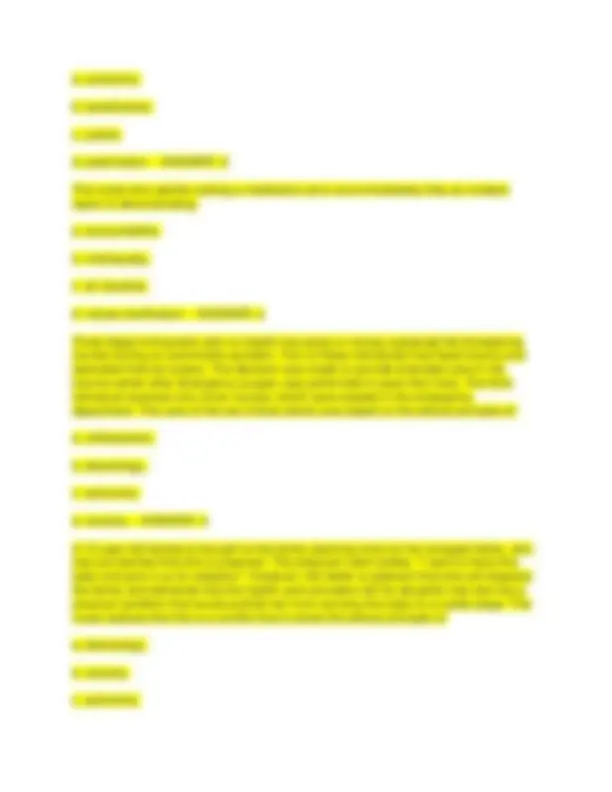
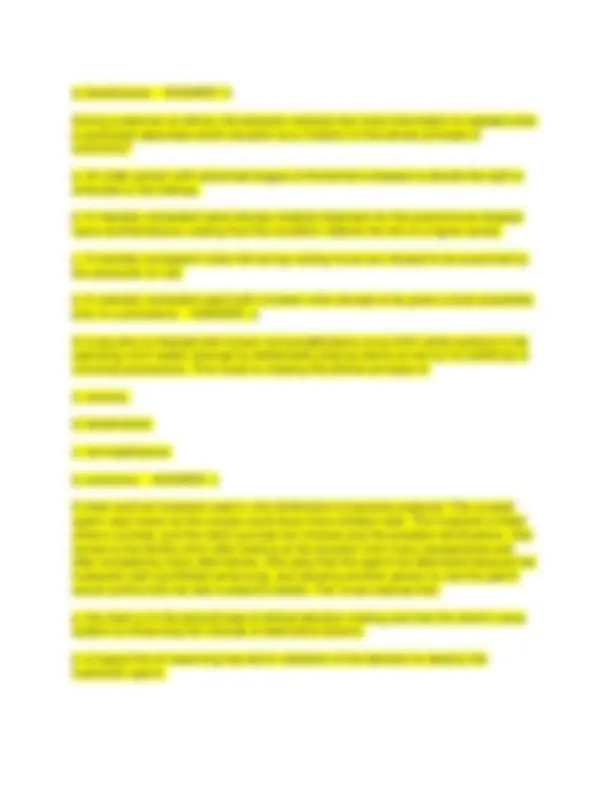
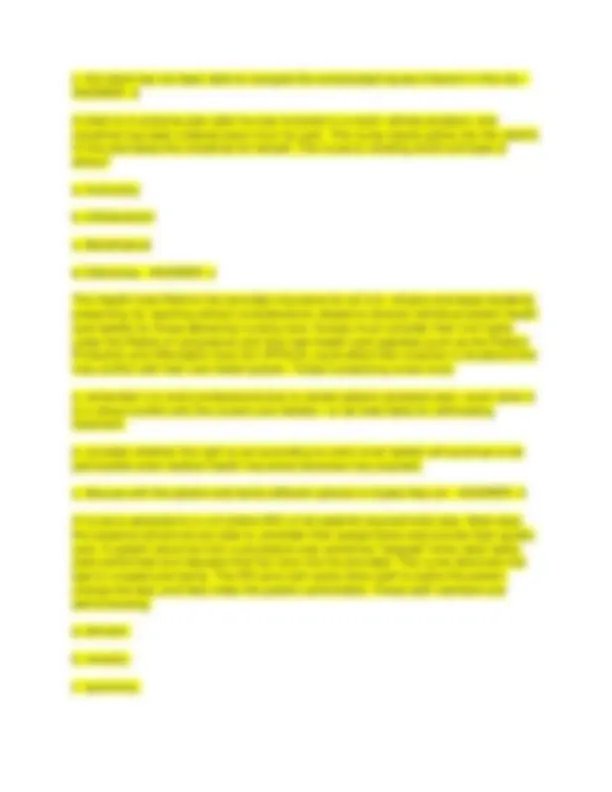
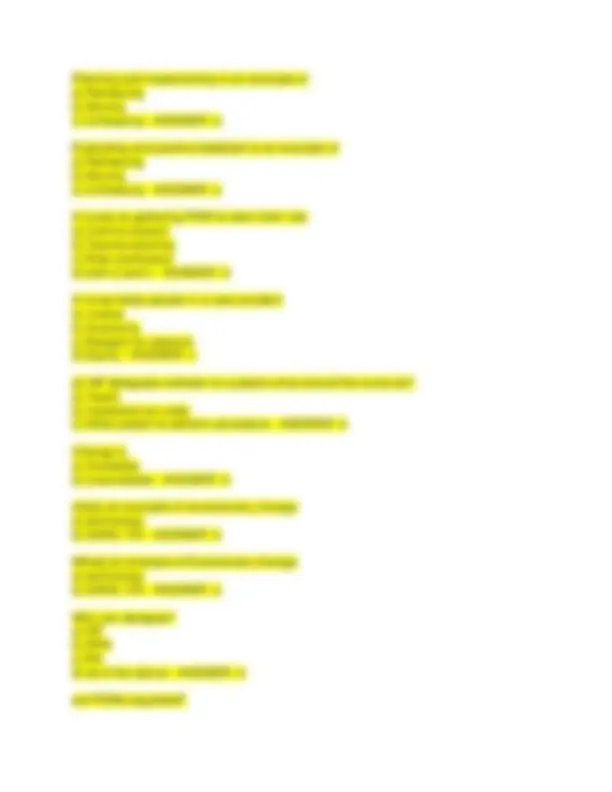
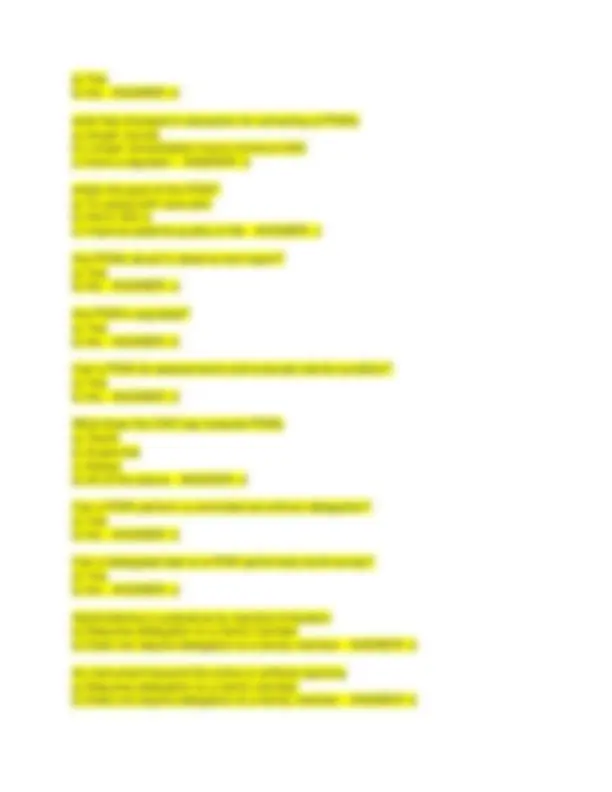
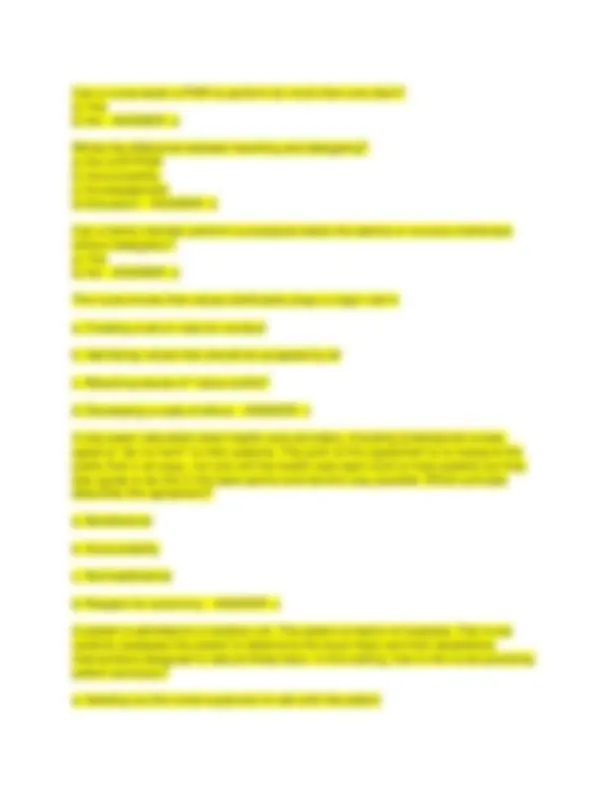
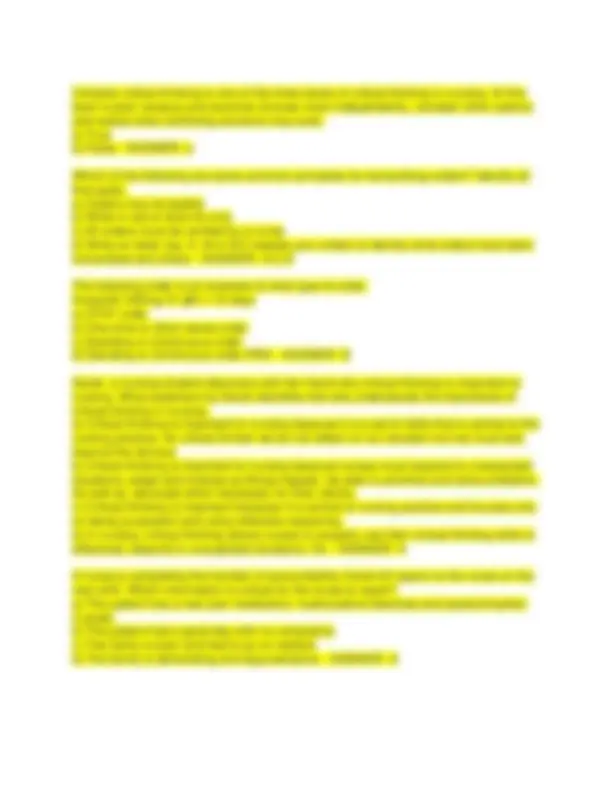
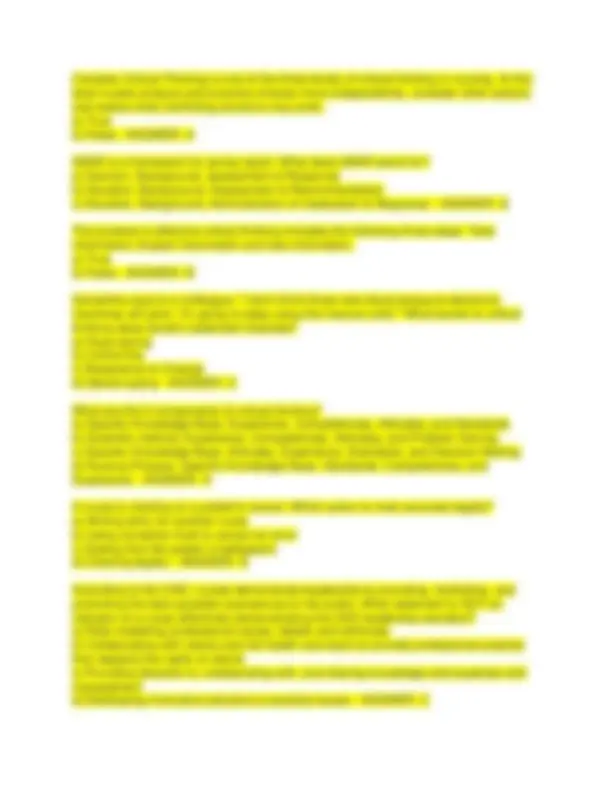
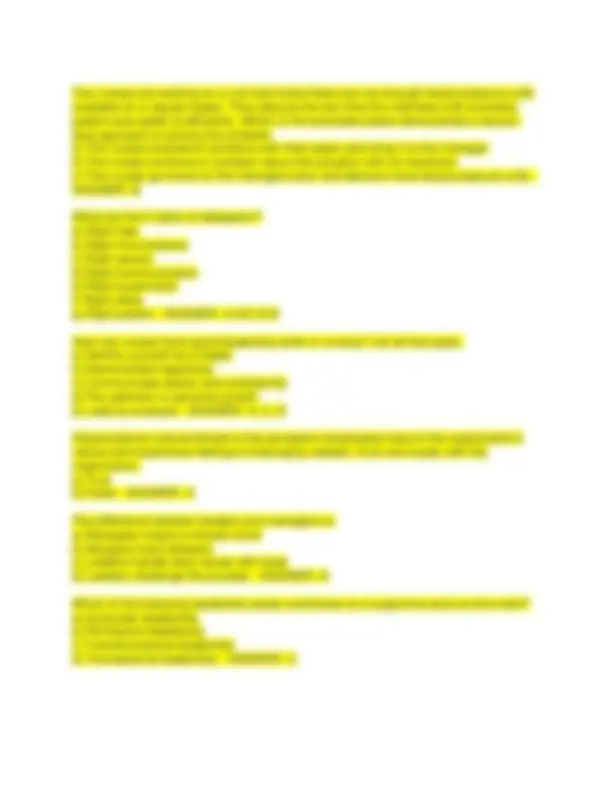
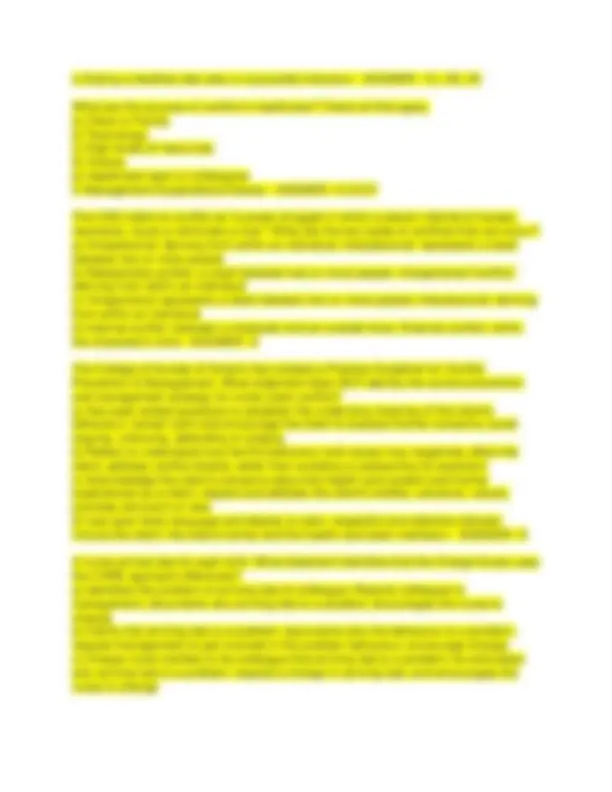
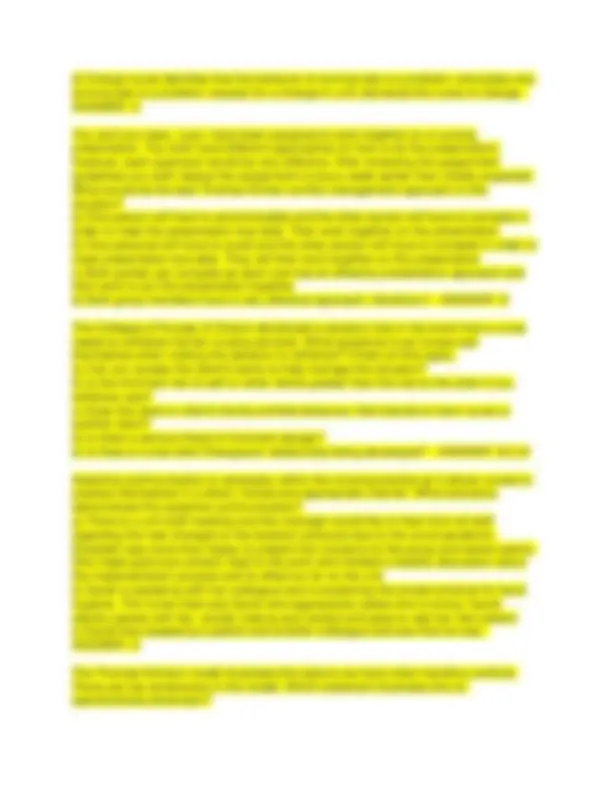
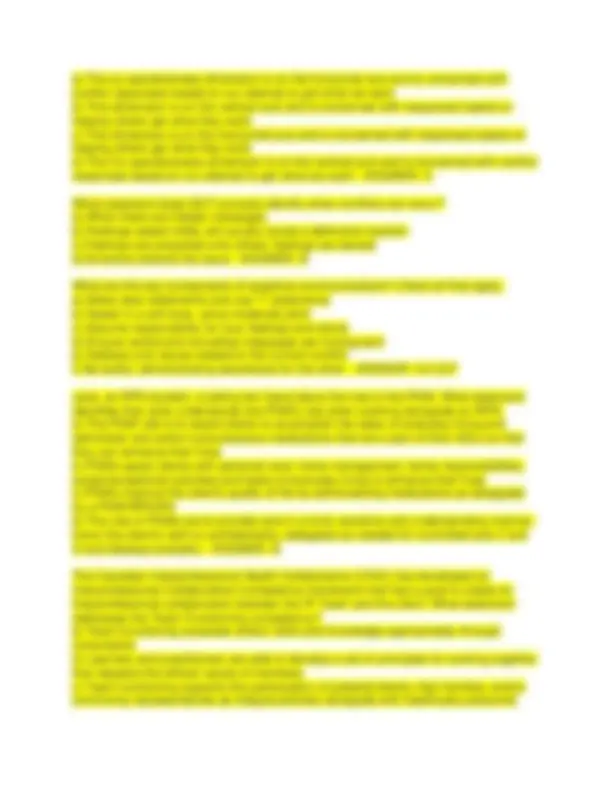
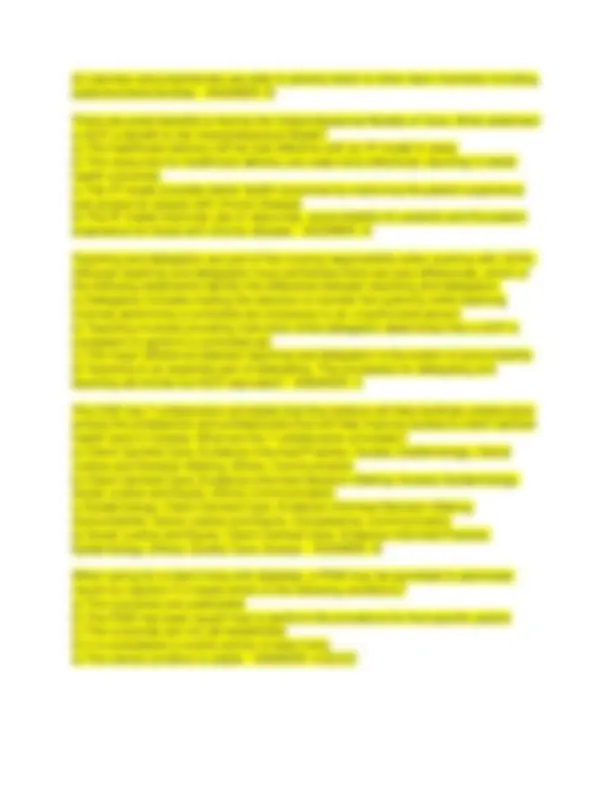
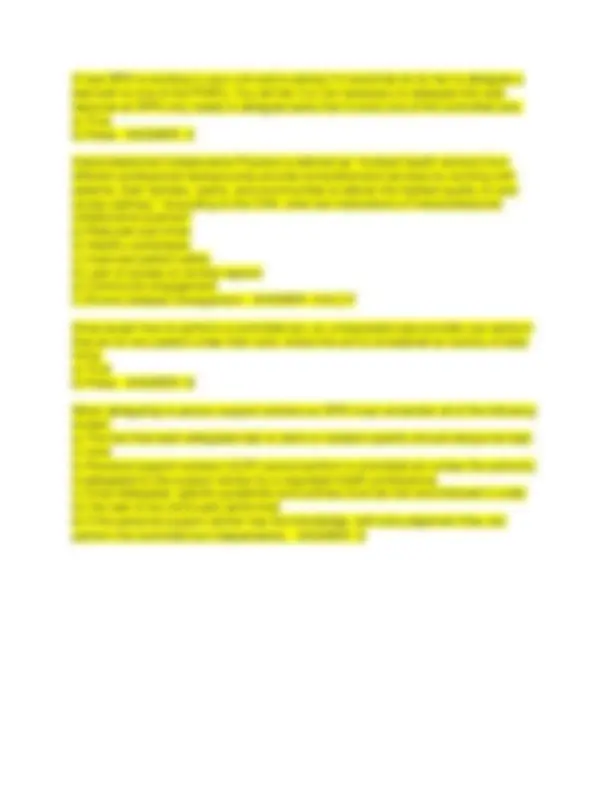



Study with the several resources on Docsity

Earn points by helping other students or get them with a premium plan


Prepare for your exams
Study with the several resources on Docsity

Earn points to download
Earn points by helping other students or get them with a premium plan
Community
Ask the community for help and clear up your study doubts
Discover the best universities in your country according to Docsity users
Free resources
Download our free guides on studying techniques, anxiety management strategies, and thesis advice from Docsity tutors
Dos Ii Final - Wk 7-12 Questions With Correct Detailed Answers 2025.pdf
Typology: Exams
1 / 23

This page cannot be seen from the preview
Don't miss anything!
















Ethics applied to nursing can best be defined as: a. doing what is best for the client. b. making good decisions about care. c. care based on what should be done in keeping with the values of the client. d. rules for providing competent care that is based on scientific principles. - ANSWER- c A family requests that no additional heroic measures be instituted for their terminally ill mother who has advance directives in place. The nurse respects this decision in keeping with the principle of: a. accountability. b. autonomy. c. nonmaleficence. d. veracity. - ANSWER- b An older adult client is comatose and had one electroencephalogram that indicated no activity. The daughter is very distraught and notices her mother's hand moves when she is talking to her. The daughter asks the nurse, "Is mother responding to my voice?" The nurse, attempting to console the daughter, knows the movement was involuntary but states, "It does appear she did." The nurse is violating which principle of ethics? a. Autonomy b. Veracity c. Utilitarianism d. Deontology - ANSWER- b In attempting to decide which services should be offered to a community, the public health nurse decides to implement hypertension screening and treatment because most of the residents are hypertensive. This decision is based on the principle of:
a. veracity. b. values. c. utilitarianism. d. autonomy. - ANSWER- c A nurse is caring for a client who just consented to an elective abortion. The nurse is unsure of his/her own values as they relate to this issue. The nurse must: a. know his/her own values and how these values relate to beliefs and the philosophy of nursing. b. rid the impurities in his/her value system. c. ignore his/her own values. d. realize that values do not change and that they cannot be influenced by others. - ANSWER- a When assessing an ethical issue, the nurse must first: a. ask, "What is the issue?" b. identify all possible alternatives. c. select the best option from a list of alternatives. d. justify the choice of action or inaction. - ANSWER- a A researcher calculated the risk-to-benefit ratio and concluded that no harmful effects were associated with a survey of college sophomores. The researcher was applying the principles of: a. beneficence. b. human dignity. c. justice. d. human rights. - ANSWER- a The physician who insists on providing treatment in spite of the client's wishes because he "knows best" is reflecting:
d. beneficence. - ANSWER- b During a seminar on ethics, the educator realizes that more information is needed when a participant describes which situation as a violation of the ethical principle of autonomy? a. An older person with advanced stages of Alzheimer's disease is denied the right to ambulate in the hallway. b. A mentally competent adult refuses medical treatment for the autoimmune disease lupus erythematosus, stating that this condition reflects the will of a higher power. c. A mentally competent visitor fell during visiting hours but refused to be examined by the physician on call. d. A mentally competent adult with a broken wrist refuses to be given a local anesthetic prior to a procedure. - ANSWER- a A nurse who is infected with human immunodeficiency virus (HIV) while working in the operating room seeks revenge by deliberately placing clients at risk by not adhering to universal precautions. This nurse is violating the ethical principle of: a. veracity. b. beneficence. c. nonmaleficence. d. autonomy. - ANSWER- c A client and her husband used in vitro fertilization to become pregnant. The unused sperm was frozen so the couple could have more children later. The husband is killed while in combat, and the client journals her choices and the possible ramifications. She comes to the fertility clinic after looking at the situation from many perspectives and after considering many alternatives. She asks that the sperm be destroyed because her husband's faith prohibited remarrying, and allowing another person to use the sperm would conflict with her late husband's beliefs. The nurse realizes that: a. the client is in the second step of ethical decision making and that the client's value system is influencing her choices of alternative actions. b. a logical line of reasoning has led to validation of the decision to destroy the husband's sperm.
c. the client has not been able to navigate the complicated issues inherent in this situ - ANSWER- d A client is in extreme pain after he was involved in a motor vehicle accident, and morphine has been ordered every hour for pain. The nurse injects saline into the client's IV line and takes the morphine for herself. The nurse is violating which principle of ethics? a. Autonomy b. Utilitarianism c. Beneficence d. Dilemmas - ANSWER- c The Health Care Reform Act provides insurance for all U.S. citizens and legal residents presenting far reaching ethical considerations related to diverse individual patient health care beliefs for those delivering nursing care. Nurses must consider their civil rights under the Rights of conscience and how new health care agendas such as the Patient Protection and Affordable Care Act (PPACA) could affect their practice in situations that may conflict with their own belief system. Today's practicing nurse must: a. remember it is one's professional duty to render patient-centered care—even when it is in direct conflict with the nurse's own beliefs—or be held liable for withholding treatment. b. consider whether the right to act according to one's inner beliefs will continue to be permissible when federal health insurance becomes fully enacted. c. discuss with the patient and family different options in hopes they wil - ANSWER- b A nurse is assigned to a unit where 95% of all patients required total care. Most days the assistive personnel are able to complete their assignments and provide high-quality care. A patient returning from a procedure was somehow "skipped" when daily baths were performed and requests that her care now be provided. The nurse discovers the bed is rumpled and damp. The RN joins with some other staff to bathe the patient, change the bed, and help make the patient comfortable. These staff members are demonstrating: a. altruism. b. veracity. c. autonomy.
a) Privacy b) Confidentiality c) Equity d) Justice - ANSWER- a be fair, provide equal care a) Equity b) Justice c) Veracity d) Deontology - ANSWER- a everyone has the same resources allocated/distribution of care a) Equity b) Justice c) Veracity d) Deontology - ANSWER- b regard with honor and esteem- be the voice of all stakeholders heard in a decision. a) Deontology b) Respect for persons c) Veractity d) Autonomy - ANSWER- b being truthful having honest communication a) Deontology b) Respect for persons c) Veractity d) Autonomy - ANSWER- c Whats right and wrong, based on right making not consequences a) Ethics b) Justice c) Deontology d) Utilitarianism - ANSWER- c Consequence based on theory- greater good- effects the decision will have a) Ethics b) Justice c) Deontology d) Utilitarianism - ANSWER- d Assessing the situation is an example of a) Refreezing b) Moving c) Unfreezing - ANSWER- c
Planning and implementing is an example of a) Refreezing b) Moving c) Unfreezing - ANSWER- b Evaluating and positive feedback is an example of a) Refreezing b) Moving c) Unfreezing - ANSWER- a A nurse us gathering PSW to learn their role a) Communication b) Teamfunctioning c) Role clarification d) both b and c - ANSWER- d A nurse helps people in a care accident a) Justice b) Autonomy c) Respect for persons d) Equity - ANSWER- c an NP delegates catheter to a patient what should the nurse do? a) Teach b) Implement an order c) Allow patient to perform procedure - ANSWER- b Change is a) Avoidable b) Unavoidable - ANSWER- b whats an example of revolutionary change a) technology b) SARS- HH - ANSWER- b Whats an example of Evolutionary change a) technology b) SARS- HH - ANSWER- a Who can delegate? a) NP b) RPN c) RN d) all of the above - ANSWER- d are PSWs regulated?
Can a nurse teach a PSW to perform for more than one client? a) Yes b) No - ANSWER- a Whats the difference between teaching and delegating? a) the UCP/PSW b) Accountability c) Knowledge/skill d) Education - ANSWER- b Can a family member perform a procedure below the dermis or mucous membrane without delegation? a) Yes b) No - ANSWER- b The nurse knows that values clarification plays a major role in a. Creating a set of rules for conduct b. Identifying values that should be accepted by all c. Resolving issues of "value conflict" d. Developing a code of ethics - ANSWER- c It may seem redundant when health care providers, including professional nurses, agree to "do no harm" to their patients. The point of this agreement is to reassure the public that in all ways, not only will the health care team work to heal patients but they also agree to do this in the least painful and harmful way possible. Which principle describes this agreement? a. Beneficence b. Accountability c. Nonmaleficence d. Respect for autonomy - ANSWER- c A patient is admitted to a medical unit. The patient is fearful of hospitals. The nurse carefully assesses the patient to determine the exact fears and then establishes interventions designed to reduce these fears. In this setting, how is the nurse practising patient advocacy? a. Seeking out the nurse supervisor to talk with the patient
b. Documenting patient fears in the medical record in a timely manner c. Working to change the hospital environment d. Assessing the patient's point of view and preparing to articulate it - ANSWER- d If a nurse assesses a patient for pain and then offers a plan to manage the pain, the principle that encourages the nurse to monitor the patient's response to the plan is a. Beneficence b. Justice c. Nonmaleficence d. Respect for autonomy - ANSWER- d Including patients in decision making regarding their care and respecting their choices of treatment demonstrate the principle of a. Beneficence b. Autonomy c. Justice d. Veracity - ANSWER- b Nurses agree to be advocates for their patients. Which nursing action has the highest priority? a. Seek out a nursing supervisor in situations involving conflict b. Work to understand the law as it applies to the patient's clinical condition c. Assess the patient's point of view and prepare to articulate this point of view d. Document all clinical changes in the medical record in a timely manner - ANSWER- c Which action is not part of the nurse's role as patient advocate? a. Intervening if other people fail to respect the patient's dignity b. Protecting the patient's right to confidentiality and privacy
Complex critical thinking is one of the three levels of critical thinking in nursing. At this level nurses' analyze and examine choices more independently, consider other options and realize what conflicting solutions may exist. a) True b) False - ANSWER- a Which of the following are some common principles for transcribing orders? Identify all that apply. a) Orders may be legible b) Write in red or blue ink only c) All orders must be verified by a nurse d) Write an letter (eg. K, M or EC) beside your orders to identify what orders have been transcribed and where - ANSWER- A,C,D The following order is an example of what type of order: Ampicillin 500mg IV q8h x 10 days a) STAT order b) One-time or Short series order c) Standing or Continuous order d) Standing or Continuous order PRN - ANSWER- B Sarah, a nursing student discovers with her friend why critical thinking is important to nursing. What statement by Sarah identifies that she understands the importance of critical thinking in nursing. a) Critical thinking is important to nursing because it is a set of skills that is central to the nursing practice. As critical thinker we do not reflect on our situation but we must look beyond the obvious b) Critical thinking is important to nursing because nurses must respond to unexpected situations, adapt and change as things happen, be able to prioritize and solve problems. As well as, advocate when necessary for their clients. c) Critical thinking is important because it is central to nursing practice and focuses only on being purposeful and using reflective reasoning. d) In nursing, critical thinking allows nurses to properly use their critical thinking skills to effectively respond to unexpected situations. Ho - ANSWER- A A nurse is completing the transfer of accountability (hand-off report) to the nurse on the next shift. Which information is critical for the nurse to report? a) The patient has a new pain medication, hydrocodone bitartrate and acetaminophen (Lortab) b) The patient had a good day with no complaints c) The family is poor and had to go on welfare d) The family is demanding and argumentative - ANSWER- A
Complex Critical Thinking is one of the three levels of critical thinking in nursing. At this level nurses analyze and examine choices more independently, consider other options and realize what conflicting solutions may exist. a) True b) False - ANSWER- A SBAR is a framework for giving report. What does SBAR stand for? a) Solution, Background, assessment & Response b) Situation, Background, Assessment & Recommendation c) Situation, Background, Administration of medication & Response - ANSWER- B The process to effective critical thinking includes the following three steps: Take information, Explain information and Use information. a) True b) False - ANSWER- B Samantha says to a colleague, "I don't think those new blood pressure electronic machines will work. I'm going to keep using the manual cuffs." What barrier to critical thinking does Sarah's statement illustrate? a) Face-saving b) Conformity c) Resistance to Change d) Stereo-typing - ANSWER- C What are the 5 components of critical thinking? a) Specific Knowledge Base, Experience, Competencies, Attitudes, and Standards b) Scientific method, Experience, Competencies, Attitudes, and Problem Solving c) Specific Knowledge Base, Attitudes, Experience, Standards, and Decision Making d) Nursing Process, Specific Knowledge Base, Standards, Competencies, and Experience - ANSWER- A A nurse is charting on a patient's record. Which action is most accurate legally? a) Writing entry for another nurse b) Using correction fluid to correct an error c) Stating that the patient is belligerent d) Charting legally - ANSWER- D According to the CNO, nurses demonstrate leadership by providing, facilitating, and promoting the best possible care/service to the public. What statement is NOT an indicator of a nurse effectively demonstrating the CNO leadership standard? a) Role-modelling professional values, beliefs and attributes b) Collaborating with clients and the health care team to provide professional practice that respects the rights of clients c) Providing direction to, collaborating with, and sharing knowledge and expertise with management d) Developing innovative solutions to practice issues - ANSWER- C
The difference between a democratic leadership style and an autocratic leadership style is that the leader works with management to make decisions offering guidance and allows for participative decision making. a) True b) False - ANSWER- B Nurse leaders use transformational leadership practices to create and sustain healthy work. What statement identifies transformational leadership practices? a) Building relationships and trust, creating an empowering work environment b) Creating a culture that supports development of integrity and integration c) Focusing on leading change only d) Balancing competing values, ethics, goals and priorities - ANSWER- A Good leaders have which type of attributes? a) Firm structure b) Loyalty c) Shared vision d) Knowledge of others - ANSWER- C Each of the following are reasons for nurses to engage in political activity and be politically aware, with the exception of: a) Nurses need to fight for equality with other interprofessional team members b) Nurses have a unique perspective and knowledge of health related issues c) Nurses are successful advocates d) Nurses have creditability with the public - ANSWER- A Quality improvement processes would be an example of what type of change? a) Revolutionary change b) Evolutionary change c) Adaptation change d) Personal change - ANSWER- B Lewin's model of change defines driving forces as the energy used to motivate change. Which of the following would be considered a driving force? a) Provincial funding for decreased wait times b) Continuing the status quo c) Professional restraint d) Staff skills to complete a task - ANSWER- A Nurses play a significant role in change, due to their inherent responsibility to the public. Therefore, they must be involved in advocating for change politically as well as being involved in advocating for both professional and clinical issues. a) True b) False - ANSWER- A
According to the Lewin's Management Change Model articles, some practical steps for using the framework include the following for change: a) Empower action, ensure strong support from senior management, dispel rumours, and determine what needs to change b) Communicate often, dispel rumours, empower action, and involve people in the process c) Dispel rumours, involve people in the process, empower action, promote support and training d) Communicate often, anchor the change, empower action, and involve people in the process - ANSWER- B One of the factors that make nurses more politically aware is knowledge of the issue. What question could you ask yourself regarding knowledge of the issue? a) What needs are currently being met? b) Who will be disadvantaged? c) Is it economically feasible? d) Is the change reasonable, acceptable & realistic? - ANSWER- A Political action is defines as the process of influencing a change in policy by affecting change in the workplace regarding clients and the allocation of clients' resources. a) True b) False - ANSWER- B Align each step of Lewin's Change Model with the appropriate response from the change agent.
d) Charge nurse identifies that the behavior of arriving late is a problem; articulates why arriving late is a problem; request for a change in unit; demands the nurse to change - ANSWER- C You and your peer, Juan, have been assigned to work together on a nursing presentation. You both have different approaches on how to do the presentation; however, each approach would be very effective. After reviewing the assignment guidelines you both realize the assignment is due a week earlier than initially expected. What would be the best Thomas-Kilman conflict management approach to this situation? a) One person will have to accommodate and the other person will have to compete in order to meet the presentation due date. Then work together on the presentation b) One personal will have to avoid and the other person will have to compete in order to meet presentation due date. They will then work together on the presentation c) Both parties can compete as each one had an effective presentation approach and then work to put the presentation together d) Both group members have a very effective approach, therefore it - ANSWER- D The Colleges of Nurses of Ontario developed a decision tree in the event that a nurse needs to withdraw his/her nursing services. What questions must nurses ask themselves when making the decision to withdraw? Check all that apply. a) Can you access the client's family to help manage the situation? b) Is the imminent risk to self or other clients greater than the risk to the client if you withdraw care? c) Does the client or client's family exhibits behaviour that intends to harm nurse or another client? d) Is there a serious threat of imminent danger? e) Is there a nurse-client therapeutic relationship being developed? - ANSWER- B,C,D Assertive communication is necessary within the nursing practice as it allows nurses to express themselves in a direct, honest and appropriate manner. What scenarios demonstrate this assertive communication? a) There is a unit staff meeting and the manager would like to hear from all staff regarding the new changes to the isolation protocols due to the covid pandemic. Elizabeth was more than happy to present her concerns to the group and spoke openly. She made good eye contact, kept to the point and initiated a healthy discussion about the implementation process and its effect so far on the unit b) Sarah is speaking with her colleague and is explaining the proper protocol for hand hygiene. The nurse interrupts Sarah and aggressively states she is wrong. Sarah silently agrees with her, avoids making eye contact and goes to see her next patient c) David was assessing a patient and another colleague and saw that he was - ANSWER- A The Thomas-Kilmann model illustrates the options we have when handling conflicts. There are two dimensions in the model. Which statement illustrates the co- operativeness dimension?
a) The co-operativeness dimension is on the horizontal axis and is concerned with conflict responses based on our attempt to get what we want b) This dimension is on the vertical axis and is concerned with responses based on helping others get what they want c) This dimension is on the horizontal axis and is concerned with responses based on helping others get what they want d) The Co-operativeness dimension is on the vertical axis and is concerned with conflict responses based on our attempt to get what we want - ANSWER- C What statement does NOT correctly identify when conflicts can occur? a) When there are hidden messages b) Feelings stated mildly will usually cause a defensive reaction c) Feelings are projected onto others; feelings are denied d) Emotions distorts the issue - ANSWER- B What are the key components of assertive communications? Check all that apply. a) Make clear statements and use "I" statements b) Speak in a soft tone, using moderate pitch c) Assume responsibility for your feelings and wants d) Ensure verbal and nonverbal messages are incongruent e) Address only issues related to the current conflict f) Be tactful, demonstrating awareness for the other - ANSWER- A,C,E,F Jane, an RPN student, is telling her friend about the role of the PSW. What statement identifies that Jane understands the PSW's role when working alongside an RPN. a) The PSW role is to assist clients to accomplish the tasks of everyday living and administer oral and/or subcutaneous medications that are a part of their ADLs so that they can enhance their lives b) PSWs assist clients with personal care, home management, family responsibilities, social/recreational activities and tasks of everyday living to enhance their lives c) PSWs improve the client's quality of life by administering medications as delegated by a PSW/RPN/RN d) The role of PSWs are to provide care in a kind, sensitive and understanding manner, honor the client's right to confidentiality, delegates as needed for controlled acts II and III and displays empathy - ANSWER- B The Canadian Interprofessional Health Collaborative (CIHC) has developed an Interprofessional Collaborative Competency framework that has a goal to create an Interprofessional collaboration between the IP Team and the client. What statement addresses the Team Functioning competency? a) Team functioning accesses others' skills and knowledge appropriately through consultation b) Learners and practitioners are able to develop a set of principles for working together that respects the ethical values of members c) Team functioning supports the participation of patients/clients, their families, and/or community representatives as integral partners alongside with healthcare personnel